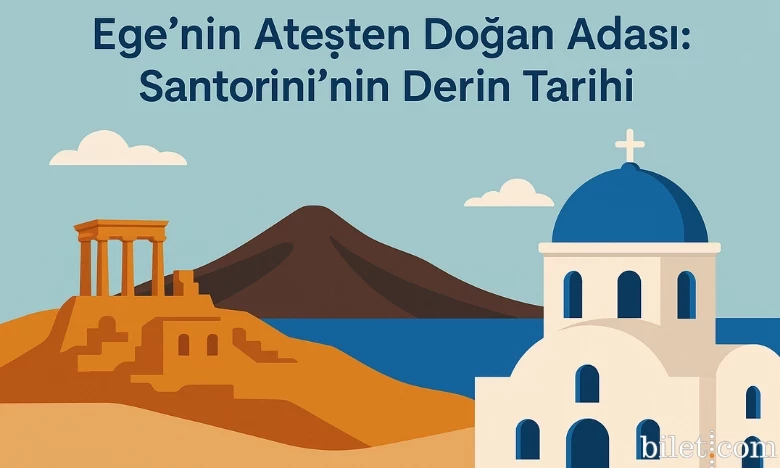Far beyond the picture-perfect landscapes that captivate millions of tourists each year, Santorini, nestled in the Aegean Sea, holds a special place in the memory of Mediterranean civilizations with its millennia-old history. The volcanic eruptions that shaped the island's present-day appearance, the rise and fall of ancient civilizations, the rule of Venetian princes, and the long-lasting Ottoman dominance make Santorini not just a holiday destination but a living museum of history.
A Legend Born from a Volcano
Santorini's history is a story shaped by fire, seemingly emanating from the heart of the earth. The Thera Volcano eruption , which occurred around 1600 BC, transformed the entire island. This eruption brought about the end not only of the island but also of many surrounding civilizations. The ancient settlement of Akrotiri, buried under the lava of this eruption, has remained remarkably preserved to this day. In this respect, Santorini is often compared to Pompeii in Italy.
The Thera eruption was so massive that scientists believe it may have inspired global climate change and even the legend of Atlantis . The caldera (depression pit) formed by the volcano is today Santorini's most characteristic geographical feature, and this dramatic landscape attracts thousands of photographers and nature enthusiasts to the island every year.
From Minoans to Dorians: Ancient Period
Although no signs of life remained on the island for a long time after the eruption, settlement gradually resumed. First, small settlements under Minoan influence arrived, then Dorian tribes. The Dorians named the island "Thera." The ruins of Ancient Thera , which can be visited today, offer traces of life from the 9th century BC to the Roman period.
Many structures at the ancient city of Thera, including the agora, theater, temples, baths, and tombs, remain standing. Inscriptions, particularly from the Hellenistic period, indicate that the site was home to an educated and organized society. During the Roman period, the island gained importance for its wine production and maritime trade.
Traces of Byzantium and Christianity
During the Byzantine Empire, Christianity began to dominate Santorini. This period led to the rapid spread of churches and religious structures across the island. The small white churches and blue domes seen in nearly every village on Santorini today are modern examples of this period's architectural legacy.
Remains of frescoes in some places demonstrate the influence of Byzantine art on the local population. Castles and tower houses in villages such as Pyrgos and Emporio provide clues about how the people built defenses against pirate attacks during this period.
The Venetian Era and the Birth of the Name “Santorini”
As Byzantine rule weakened following the Fourth Crusade in 1204, the island fell into Venetian hands. After 1207, the Santo Signore family of Venetian origin established control of the island. During this period, the island acquired its current name: Santorini , named after the island's Saint Irene (Santa Irini).
The Venetians built defensive castles on the island, and villages were relocated to higher elevations. During this period of active Mediterranean trade, Santorini was reinforced with defensive structures to prevent it from becoming a pirate haven. Winemaking, ceramics, and agricultural exports also flourished.
Santorini in the Ottoman Empire
Santorini came under Ottoman rule in 1579 and remained so until the Greek War of Independence in 1821. During the Ottoman era, the island enjoyed a wide degree of autonomy. The local population, which maintained its own internal administration in exchange for taxes, was able to continue its commercial activities.
During this period, many Ottoman structures such as mosques or baths were not built on the island because the islanders were predominantly Christian and the government preferred not to interfere. However, it appears frequently in Ottoman archives as Santorini (Santoron) , and its reputation for wine and textiles is documented.
Accession to Modern Greece and the Tourism Boom
Santorini was officially incorporated into the modern Kingdom of Greece in 1830, following Greece's independence from the Ottoman Empire. Maritime trade, particularly the export of Santorini wine and sponges, revitalized the island economically in the 19th century.
However, the massive earthquakes of 1956 caused significant devastation, forcing some residents to abandon the island. The wave of tourism that began after the 1970s ushered in a new era for the island. Today, Santorini appeals to a diverse range of tourists, from honeymooners to history buffs.
Where Can You See Traces of History?
Akrotiri Archaeological Site : City ruins from the 17th century BC, buried under lava.
Ancient City of Thera : The summit of Mesa Vouno, where Doric and Hellenistic period ruins are located.
Pyrgos & Emporio Villages : Medieval castles, narrow streets, defensive architecture.
Fira Archaeological Museum : A collection full of ceramics, inscriptions, frescoes and historical documents.
Santorini Wine Museum : An interactive experience that sheds light on the island's famous winemaking history.







